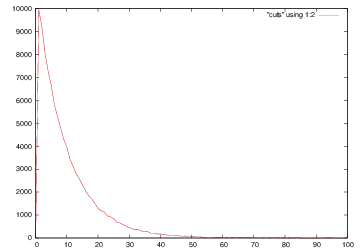If I cut a string at random (uniformly distributed) positions, what is the distribution of lengths of the resulting fragments?
From what I understand the lengths should be distributed as a negative exponential (which my simulation below appears to confirm). I intuitively understand this as the probability of having encountered a break increases exponentially with length. Is this correct as this similar question suggests?
I have a collaborator who suggests this should be a Poisson distribution, is this incorrect? I assume the number of breaks in a region of the string is Poisson distributed is this correct?
Simulation I've simulated this with a string of length 1000000 and 100000 random cuts (I have also simulated with a fixed cut probability at each point and get similar results). I only cut at integral positions (my simulation creates a sequence, then adds cuts and calculates the length).
